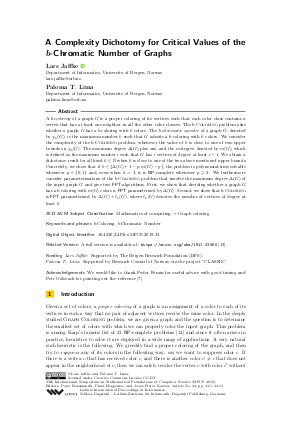A Complexity Dichotomy for Critical Values of the b-Chromatic Number of Graphs
Authors
Lars Jaffke  ,
Paloma T. Lima
,
Paloma T. Lima
-
Part of:
Volume:
44th International Symposium on Mathematical Foundations of Computer Science (MFCS 2019)
Part of: Series: Leibniz International Proceedings in Informatics (LIPIcs)
Part of: Conference: Mathematical Foundations of Computer Science (MFCS) - License:
 Creative Commons Attribution 3.0 Unported license
Creative Commons Attribution 3.0 Unported license
- Publication Date: 2019-08-20
File

PDF
LIPIcs.MFCS.2019.34.pdf
- Filesize: 0.63 MB
- 13 pages
Document Identifiers
Related Versions
-
A full version is available at: https://arxiv.org/abs/1811.03966 [Jaffke and Lima, 2018].
Subject Classification
ACM Subject Classification
- Mathematics of computing → Graph coloring
Keywords
- b-Coloring
- b-Chromatic Number
Metrics
- Access Statistics
-
Total Accesses (updated on a weekly basis)
0PDF Downloads0Metadata Views
Abstract
A b-coloring of a graph G is a proper coloring of its vertices such that each color class contains a vertex that has at least one neighbor in all the other color classes. The b-Coloring problem asks whether a graph G has a b-coloring with k colors. The b-chromatic number of a graph G, denoted by chi_b(G), is the maximum number k such that G admits a b-coloring with k colors. We consider the complexity of the b-Coloring problem, whenever the value of k is close to one of two upper bounds on chi_b(G): The maximum degree Delta(G) plus one, and the m-degree, denoted by m(G), which is defined as the maximum number i such that G has i vertices of degree at least i-1. We obtain a dichotomy result for all fixed k in N when k is close to one of the two above mentioned upper bounds. Concretely, we show that if k in {Delta(G) + 1 - p, m(G) - p}, the problem is polynomial-time solvable whenever p in {0, 1} and, even when k = 3, it is NP-complete whenever p >= 2. We furthermore consider parameterizations of the b-Coloring problem that involve the maximum degree Delta(G) of the input graph G and give two FPT-algorithms. First, we show that deciding whether a graph G has a b-coloring with m(G) colors is FPT parameterized by Delta(G). Second, we show that b-Coloring{} is FPT parameterized by Delta(G) + l_k(G), where l_k(G) denotes the number of vertices of degree at least k.
Cite As Get BibTex
Lars Jaffke and Paloma T. Lima. A Complexity Dichotomy for Critical Values of the b-Chromatic Number of Graphs. In 44th International Symposium on Mathematical Foundations of Computer Science (MFCS 2019). Leibniz International Proceedings in Informatics (LIPIcs), Volume 138, pp. 34:1-34:13, Schloss Dagstuhl – Leibniz-Zentrum für Informatik (2019)
https://doi.org/10.4230/LIPIcs.MFCS.2019.34
BibTex
@InProceedings{jaffke_et_al:LIPIcs.MFCS.2019.34,
author = {Jaffke, Lars and Lima, Paloma T.},
title = {{A Complexity Dichotomy for Critical Values of the b-Chromatic Number of Graphs}},
booktitle = {44th International Symposium on Mathematical Foundations of Computer Science (MFCS 2019)},
pages = {34:1--34:13},
series = {Leibniz International Proceedings in Informatics (LIPIcs)},
ISBN = {978-3-95977-117-7},
ISSN = {1868-8969},
year = {2019},
volume = {138},
editor = {Rossmanith, Peter and Heggernes, Pinar and Katoen, Joost-Pieter},
publisher = {Schloss Dagstuhl -- Leibniz-Zentrum f{\"u}r Informatik},
address = {Dagstuhl, Germany},
URL = {https://drops.dagstuhl.de/entities/document/10.4230/LIPIcs.MFCS.2019.34},
URN = {urn:nbn:de:0030-drops-109784},
doi = {10.4230/LIPIcs.MFCS.2019.34},
annote = {Keywords: b-Coloring, b-Chromatic Number}
}
Author Details
Funding
- Jaffke, Lars: Supported by The Bergen Research Foundation (BFS).
- Lima, Paloma T.: Supported by Research Council of Norway via the project "CLASSIS".
Acknowledgements
We would like to thank Fedor Fomin for useful advice with good timing and Petr Golovach for pointing out the reference [Dabrowski et al., 2015].
References
-
Pierre Aboulker, Nick Brettell, Frédéric Havet, Dániel Marx, and Nicolas Trotignon. Coloring Graphs with Constraints on Connectivity. J. Graph Theory, 85(4):814-838, 2017.

-
Dominique Barth, Johanne Cohen, and Taoufik Faik. On the b-continuity property of graphs. Discrete Appl. Math., 155:1761-1768, 2007.

-
Andreas Björklund, Thore Husfeldt, and Mikko Koivisto. Set Partitioning via Inclusion-Exclusion. SIAM J. Comput., 39(2):546-563, 2009.

-
Victor Campos, Carlos Vinicius G. C. Lima, and Ana Silva. Graphs of girth at least 7 have high b-chromatic number. Eur. J. Combin., 48:154-164, 2015.

-
Miroslav Chelbík and Janka Chlebíkova. Hard Coloring Problems in Low Degree Planar Bipartite Graphs. Discrete Appl. Math., 154:1960-1965, 2006.

-
Marek Cygan, Fedor V. Fomin, Lukasz Kowalik, Daniel Lokshtanov, Daniel Marx, Marcin Pilipczuk, Michał Pilipczuk, and Saket Saurabh. Parameterized Algorithms. Springer, 1st edition, 2015.

-
Konrad K. Dabrowski, François Dross, Matthew Johnson, and Daniël Paulusma. Filling the complexity gaps for colouring planar and bounded degree graphs. In Proc. IWOCA '15, volume 9538 of Lecture Notes in Computer Science, pages 100-111. Springer, 2015.

-
Rodney G. Downey and Michael R. Fellows. Fundamentals of Parameterized Complexity. Texts in Computer Science. Springer, 2013.

-
Esther Galby, Paloma T. Lima, Daniël Paulusma, and Bernard Ries. On the Parameterized Complexity of k-Edge Colouring, 2019. arXiv:1901.01861.

-
Frédéric Havet, Cláudia Linhares Sales, and Leonardo Sampaio. b-Coloring of Tight Graphs. Discrete Appl. Math., 160:2709-2715, 2012.

-
Frédéric Havet and Leonardo Sampaio. On the Grundy and b-chromatic numbers of a graph. Algorithmica, 65(4):885-899, 2013.

-
Robert W. Irving and David F. Manlove. The b-Chromatic Number of a Graph. Discrete Appl. Math., 91(1-3):127-141, 1999.

-
Lars Jaffke and Paloma T. Lima. A Complexity Dichotomy for Critical Values of the b-Chromatic Number of Graphs. CoRR, 2018. arXiv:1811.03966.

-
Richard M. Karp. Reducibility among combinatorial problems. In Complexity of Computer Computations, pages 85-103. Springer, 1972.

-
Jan Kratochvíl, Zsolt Tuza, and Margit Voigt. On the b-Chromatic Number of Graphs. In Proc. WG '02, volume 2573 of LNCS, pages 310-320, 2002.

-
Fahad Panolan, Geevarghese Philip, and Saket Saurabh. On the parameterized complexity of b-Chromatic Number. J. Comput. Syst. Sci., 84:120-131, 2017.

-
Leonardo Sampaio. Algorithmic Aspects of Graph Coloring Heuristics. PhD thesis, Université Nice Sophia Antipolis, France, 2012.

